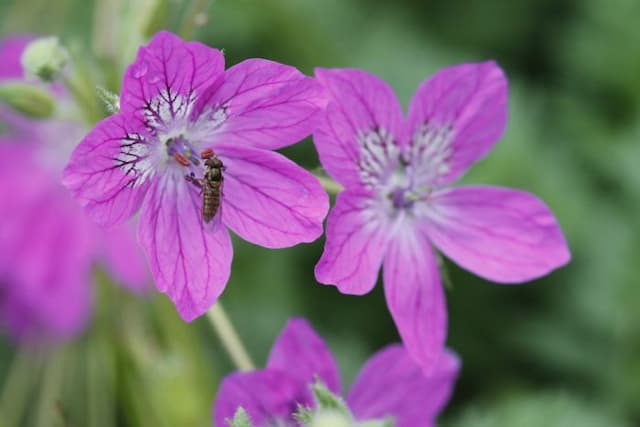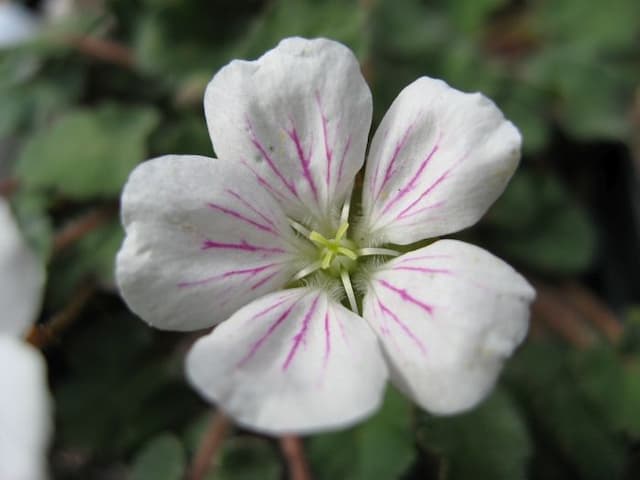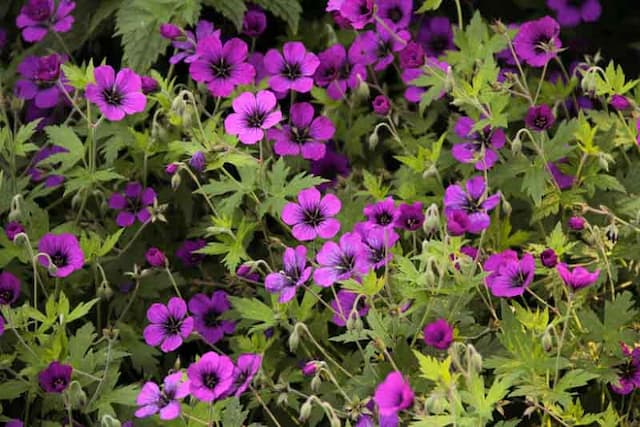Geranium Pelargonium 'Sancho Panza' (Dec)

ABOUT
Pelargonium 'Sancho Panza' is characterized by its showy and attractive appearance. The plant is graced with rounded leaves that have a slightly velvety texture and are often marked with a darker zone, which accentuates their bright green color. The edges of the leaves may be softly toothed, giving them a delicate, lacy look. This variety is particularly known for its vibrant flowers, which bloom in clusters. The flowers themselves present an eye-catching combination of colors. Each petal is usually adorned with two distinct shades, which may range from deep, rich tones to softer hues, creating a stunning contrast that catches the eye. The stunning flowers have a classic look, reminiscent of cottage garden charm and bring a bright splash of color wherever they are grown. Adding to its appeal, Pelargonium 'Sancho Panza' produces these beautiful flowers for an extended period, which typically lasts from spring through autumn, providing long-lasting visual interest. The bloom stems rise gracefully above the foliage, making the flowers a focal point of the plant. Overall, the appearance of Pelargonium 'Sancho Panza' is one of lush foliage and abundant, showy flowers which contribute to its popularity in gardens and as a container plant. It brings a romantic and traditional aesthetic to any setting where it is placed.
About this plant
 Names
NamesFamily
Geraniaceae
Synonyms
Geranium, Zonal Geranium, Horseshoe Geranium
Common names
Pelargonium 'Sancho Panza'
 Toxicity
ToxicityTo humans
Pelargoniums, commonly known as geraniums, are not considered highly toxic to humans. However, ingesting any part of the plant may cause minor symptoms such as nausea, vomiting, or diarrhea in some individuals. If you suspect ingestion, it is advisable to seek medical attention, especially in the case of children or sensitive individuals, to ensure appropriate care.
To pets
Geraniums can be toxic to pets, particularly to dogs and cats. If a pet ingests any part of a geranium, it may exhibit symptoms of poisoning which can include vomiting, anorexia, depression, dermatitis, and rarely, renal failure. It is important to keep these plants out of reach of pets, and if you suspect your pet has ingested geranium, you should contact a veterinarian promptly.
 Characteristics
CharacteristicsLife cycle
Perennials
Foliage type
Deciduous
Color of leaves
Varies
Flower color
Mixed
Height
1-2 feet (30-60 cm)
Spread
1-2 feet (30-60 cm)
Plant type
Herb
Hardiness zones
10
Native area
South Africa
Benefits
 General Benefits
General Benefits- Attractive Foliage: Pelargonium 'Sancho Panza' has uniquely patterned leaves that add visual interest to gardens and indoor spaces.
- Vibrant Flowers: The plant produces colorful flowers that can enhance the aesthetic of any environment.
- Ease of Care: It is known for being low-maintenance, making it suitable for gardeners of all skill levels.
- Drought-Tolerant: Once established, it requires minimal watering, conserving water resources.
- Garden Design: Can be used in garden beds, borders, and containers for versatile design options.
- Pest Resistance: The plant is relatively resistant to pests, reducing the need for chemical pest control.
- Long Blooming Season: It offers a long period of blooming, providing color throughout the growing season.
 Medical Properties
Medical PropertiesThis plant is not used for medical purposes.
 Air-purifying Qualities
Air-purifying QualitiesThis plant is not specifically known for air purifying qualities.
 Other Uses
Other Uses- Pelargonium's fragrant leaves can be used to impart scent to linens and clothing when placed in drawers or closets.
- The petals of Geraniums can be crystallized and used as edible decorations for desserts and sweets, giving them a unique floral touch.
- Some Geranium cultivars, with their bright and colorful flowers, are often used in artistic arrangements and as subjects in photography to enhance visual aesthetics.
- Geranium leaves can be simmered in water to create a fragrant steam that can be used for a relaxing and therapeutic experience during baths.
- The vividness of the Geranium blooms can be captured in natural dyes for textiles, providing a range of pink and purple hues.
- Pressed Geranium flowers can be incorporated into handmade paper, adding texture and visual appeal to the final product.
- Sachets filled with dried Geranium leaves and flowers can act as a natural moth repellent to protect delicate woolens.
- Geranium plants are sometimes used in educational settings, such as schools and workshops, to teach botany and the life cycle of plants.
- The sturdy stems of mature Geranium plants can be crafted into small, rustic wreaths and other eco-friendly decorations.
- As part of a sensory garden, Geraniums play an important role due to their variety of textures and scents, which can be therapeutic for individuals with sensory processing issues.
Interesting Facts
 Feng Shui
Feng ShuiThe Geranium is not used in Feng Shui practice.
 Zodiac Sign Compitability
Zodiac Sign CompitabilityThe Geranium is not used in astrology practice.
 Plant Symbolism
Plant Symbolism- Stability and Grounding: The Pelargonium 'Sancho Panza', also known as geranium, is often associated with stability and the grounding presence of Sancho Panza, the steadfast companion of Don Quixote in literature, symbolizing loyalty and practicality.
- Comfort: Geraniums are also symbolic of comfort, providing a sense of solace and peace, much like the character Sancho Panza offered to Don Quixote during his adventures.
- Fertility: With their lush blooms, geraniums can represent fertility and new growth, signifying the potential for new beginnings and prosperity.
- Friendship: Like the companionship between the characters of Don Quixote and Sancho Panza, geraniums are often used to represent close friendship and camaraderie.
- Health and Healing: Traditionally, geraniums are linked to health and healing properties, reflecting the restorative and nurturing aspects of the plant.
 Water
WaterGeraniums like Pelargonium 'Sancho Panza' prefer their soil to be kept evenly moist during their active growing season. Generally, this means watering them every seven to ten days, but this can vary depending on environmental conditions. To water, add water slowly at the base of the plant until the top inch of the soil feels damp but not soggy, using approximately 8 to 16 ounces of water, depending on the size of the pot and the plant's needs. During the winter months, when the plant is not actively growing, reduce watering frequency to prevent root rot.
 Light
LightGeraniums require bright, indirect sunlight to thrive. Place Pelargonium 'Sancho Panza' in a location where it can receive about 6 to 8 hours of sunlight daily without being exposed to the harsh midday sun. An eastern or western exposure with some protection, such as a sheer curtain, would be ideal to prevent leaf burn while ensuring adequate light.
 Temperature
TemperatureGeraniums perform best in temperatures ranging from 55 to 80 degrees Fahrenheit. They can tolerate cooler temperatures down to about 30 degrees Fahrenheit, but freezing temperatures will damage or kill the plant. Ideally, maintain a temperature around 65 to 70 degrees Fahrenheit to keep your Pelargonium 'Sancho Panza' healthy.
 Pruning
PruningRegular pruning keeps geraniums like Pelargonium 'Sancho Panza' bushy and prevents them from becoming leggy. Trim back the plant lightly throughout the growing season to encourage branching and remove any dead or yellowing leaves or spent blooms. A more thorough pruning can be done in early spring or late fall, cutting the plant back by one-third to one-half to promote vigorous growth and maintain its shape.
 Cleaning
CleaningAs needed
 Soil
SoilGeranium 'Sancho Panza' flourishes in a soil mix that is well-draining and fertile. A combination of equal parts potting soil, peat moss, and perlite or sand would create an ideal environment for its roots. This geranium prefers a soil pH between 6.0 and 7.0.
 Repotting
RepottingGeranium 'Sancho Panza' should be repotted every 1 to 2 years to refresh the soil and accommodate root growth. Observe the plant for signs of being root-bound as an indicator for repotting.
 Humidity & Misting
Humidity & MistingGeranium 'Sancho Panza' is adaptable to average indoor humidity levels. Aim to maintain humidity around 40-60% for optimal growth, avoiding overly dry or excessively moist air.
 Suitable locations
Suitable locationsIndoor
Provide bright light, well-draining soil, and moderate watering.
Outdoor
Place in full sun to part shade; protect from frost.
Hardiness zone
9-12 USDA
 Life cycle
Life cycleGeranium 'Sancho Panza' (Dec) begins its life cycle from seed or cuttings, with germination or rooting typically occurring in a warm, moist environment. After rooting, the seedling or young plant undergoes vegetative growth, developing leaves and stems. The plant then enters the maturity phase, where it starts flowering, producing showy blooms that can attract pollinators. Following pollination, the geranium may produce seeds, thus completing the reproductive cycle. As a perennial, 'Sancho Panza' enters a period of dormancy during the colder months, conserving energy. With the return of favorable conditions in spring, the plant emerges from dormancy, resuming growth and flowering, and continuing the cycle.
 Propogation
PropogationPropogation time
Early Spring
Propogation: The Pelargonium 'Sancho Panza', more commonly known as a type of Geranium, is typically propagated by stem cuttings. This method is favored for its ease and effectiveness. To propagate 'Sancho Panza' Geraniums through cuttings, one should ideally take a 4 to 6 inch (10 to 15 cm) cutting from a healthy parent plant during late spring or early summer. The cutting should include at least three sets of leaves. Before planting, the bottom leaves are removed and the cut end is dipped in rooting hormone to encourage root development. The cutting is then placed in a well-draining soil mix and kept in indirect light until roots have established, which usually takes a few weeks. During this time, the soil should be kept moist but not waterlogged to avoid rot.









![Cranesbill [Rothbury Gem]](/_next/image?url=https%3A%2F%2Fplants-admin.emdemapps.com%2Fimages%2Fplants%2F%2Fimages%2F604b6243984c2.png&w=640&q=75)